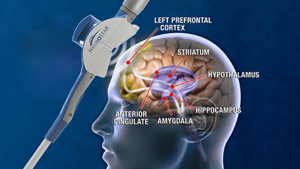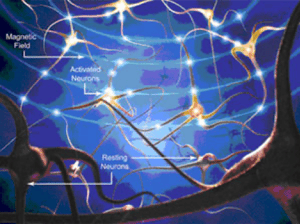 TMS is a non-invasive form of brain stimulation. It does not involve surgery, insertion of intravenous lines or anything else put into your body. Unlike Electroconvulsive Therapy (ECT). TMS does not require any anesthesia or sedation. A small electromagnetic coil controlled by a computer program is place on your head and delivers short, powerful bursts of magnetic energy focused on your brain cortex in a region shown to be involved with depression: the prefrontal cortex. The magnetic fields used in TMS are basically the same type and strength as those produced by a magnetic resonance imaging (MRI) machine.
TMS is a non-invasive form of brain stimulation. It does not involve surgery, insertion of intravenous lines or anything else put into your body. Unlike Electroconvulsive Therapy (ECT). TMS does not require any anesthesia or sedation. A small electromagnetic coil controlled by a computer program is place on your head and delivers short, powerful bursts of magnetic energy focused on your brain cortex in a region shown to be involved with depression: the prefrontal cortex. The magnetic fields used in TMS are basically the same type and strength as those produced by a magnetic resonance imaging (MRI) machine.
TMS magnetic fields do not directly affect the whole brain; they only reach about 2-3 centimeters into the brain directly beneath the treatment coil. As TMS magnetic fields move into the brain, they produce very small electrical currents in the brain tissue that activate cells within the brain called neurons. Stimulating neurons is thought to release neurotransmitters and promote changes in the strength and functioning of certain brain circuits.
A typical TMS treatment course consists of 5 treatments per week over a 6 week period, for an average of 30 total treatments. These are usually followed by 6 “taper” sessions spread out over an additional 3 weeks. Each treatment session lasts between 20-30 minutes.
 More About TMS
More About TMS
The unique nature of magnetic fields allows them to pass through the skull and into the brain cortex without being distorted in any way. This facilitates a very focal type of stimulation, minimizing the stimulation of brain tissue not involved in mood.
Once inside the brain, the dynamic (rapidly changing) nature of the magnetic pulses induces electrical charges to flow. The amount of electricity created in the brain is very small, and cannot be felt by the patient. When in the correct orientation relative to brain cells (neurons), these very small electric charges can cause the neurons to fire or become active. The objective of TMS therapy is to stimulate (or activate) brain cells thus increasing neuron plasticity (ability to form and enhance networks in the brain).
Copyright © 2023 Care New England Health System